Southwest MN IPM STUFF
All the pestilence that’s fit to print
7/12/2023
This newsletter and the advice herein are free. You usually get what you pay for.
Crop weather
Rainfall, air and soil temperatures, degree-days, soil moisture, and other current and historical weather data for the University of Minnesota Southwest Research and Outreach Center (SWROC), a little spot about two miles west of Lamberton, MN, can be found at https://swroc.cfans.umn.edu/weather.
This area has been getting rain when needed, but moisture is a big concern in much of Minnesota. I had a chance to tour a large portion of southern Minnesota last week. The takeaway was the highly variable crop status based on planting date and rainfall. The corn stage was especially variable with early-planted, early-maturity hybrids silking, and late-planted fields at V10 or even a bit less. Most soybeans are R2 with some at R3.
Weather will continue to drive yield potential as determine insect pest and crop disease pressure. Crop prices and crop insurance can complicate pest management decisions for some.
Corn
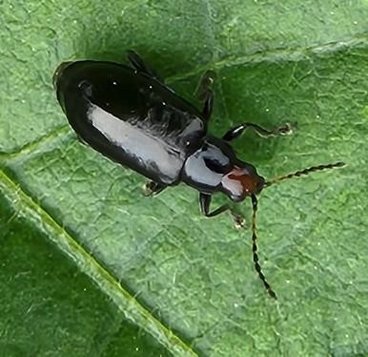
Finding small, black beetles in corn and soybeans? These are red-headed flea beetles (Figure 1). Their chewing mouthparts will produce small holes in soybean leaves and elongated strips partway through corn leaves. The beetles also feed heavily on cocklebur and several other weeds.
Occasionally, these beetles will feed on silks but economic levels of injury seldom if ever, occur. They may be active at the same time as corn rootworm beetles. Silk pruning becomes a concern only before pollination when silks are continuously pruned back to the ear tip. See silk clipping thresholds for corn rootworms.
Corn rootworms
In some areas, late corn planting, dry conditions, and low winds have helped minimize root lodging of corn rootworm-infested fields. I expect more problems will surface with recent weather and late-planted fields growing taller.
Extended diapause northern corn rootworm continues to be more common than in previous years. So far, the affected fields that I know of were not planted to a corn rootworm traited hybrid. Please let me know if you do run across rootworm-caused lodging in rotated corn fields planted to a hybrid with a rootworm trait. This re-emergence of extended diapause pressure will further complicate rootworm management. Look for a more detailed extended diapause article in an upcoming MN Crop News issue.
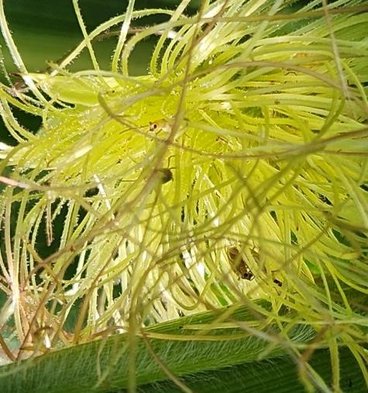
Rootworm management now should be focused on future corn crops! A possible exception is silk clipping. Pollination is often complete before peak beetle emergence, and it takes a lot of beetles (5 or more per plant) to prevent pollination. Japanese beetles can also clip silks but unlike rootworm beetles, they are usually confined to the outside rows.
Corn silks continue to grow until the ovule is pollinated. There should not be a pollination problem unless corn is less than 50% pollinated and silks are pruned to ½ inch or less. This timing will typically be too early for effective prevention of egg-laying.
Some try to manage rootworm populations by reducing egg-laying by insecticide control of rootworm beetles. Many labeled insecticide products will work but timing is a key factor. Beetles will be emerging for several more weeks and the males emerge first. Wait to apply insecticide until 10 % of the females have abdomens distended with eggs and there are 1 or more beetles/plants. Scout every seven to ten days and retreat if beetle populations reach 1/plant again.
If you are planning on “beetle bombing” as a primary tool to manage rootworm populations, you might want to reconsider your rootworm management strategy. Crop rotation and the strategic placement of Bt-traits and at-plant insecticides across the farm are useful tools.
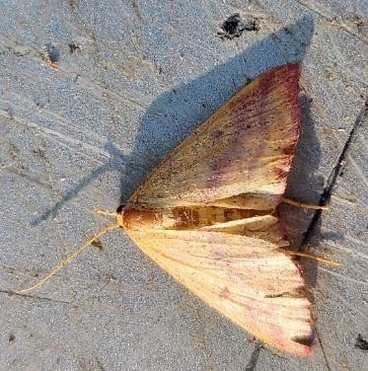
You might be seeing small moths at the edges of fields that resemble European corn borer. On closer inspection, many of these will be chickweed geometers (Figure 3).
The chickweed geometer is similar in size and color to a corn borer. While the geometer’s wings are tan to yellowish like a corn borer, the markings on the wings are red. Unlike the corn borer, the males have feathery antennae, and these moths are active during daylight hours. They are not crop pests and feed on low-growing plants like knotweed, chickweed, and clovers.
Soybean
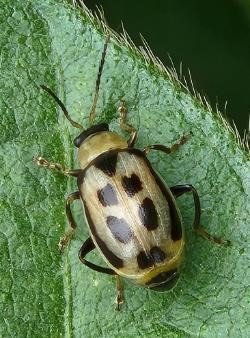
Bean leaf beetles (BLB) are once again present in early-planted soybeans as first-generation adults (Figure 4) emerge. With continued above-normal heat units we may see another generation of adults (overwintering and two generations) late this summer in SW MN.
The beetles feed on soybean leaves and late-season BLB populations may feed on pods.
There are a few southern corn rootworms (a.k.a. spotted cucumber beetles) in soybeans. They are not soybean pests but might be confused with BLB by some.
Grasshoppers
Some fields are being treated as fields are colonized by nymphs moving from roadsides and other areas where they have hatched. Larger nymphs and adults are more mobile than small nymphs. Over time, grasshopper density might be reduced as the hoppers spread further into field interiors, but the field edges could take a beating as grasshoppers grow. See last week’s IPM Stuff Notes for scouting and control tips.
Soybean aphids (SBA)
Closing canopies, moderate temperatures, and slight moisture stress could favor soybean aphid population increases over the next week. Many early-planted fields in southern Minnesota have a few aphids now, but predators and parasitic wasps have been helping suppress aphid populations. Angie Peltier, Regional Crops Extension Educator, reports observing higher SBA populations with few beneficial insects in areas of NW Minnesota.
Smaller fields of early-planted soybeans near buckthorn are likely to harbor the largest populations at this time. Fields with lower potassium, or higher nitrogen levels often see higher aphid populations. Start paying close attention to fields when 50% or more of the plants have aphids on them.
Pyrethroid resistance is still present in many SBA populations! Spraying a straight pyrethroid insecticide is likely to produce results opposite of what you hoped for. Sure, some will try it and have success, but it will probably be the other guy.
Two-spotted spider mites (TSSM) and their injury symptoms are starting to show up in some of the drought-stressed areas of Minnesota. Spider mites are favored by hot weather, drought stress, and reproductive stage soybeans. By slowing mite development rates and favoring fungal pathogens, a change to cooler, wetter (including heavy dew) weather can stop mite populations in a hurry. However, a single rain event is unlikely to stop an infestation.
You should be able to see areas of yellowing and bronzing, usually on the field edge first, and often visible from a distance when TSSM populations are near treatment levels. An agreeable accountant might let you deduct that new high-end binoculars or spotting scope you’ve been wanting as a spider mite scouting expense.
The cooler weather forecast will help slow things down. There is still a lot of growing season left so delay treating as long as possible. If yield-threatening yield populations occur early I would select a product with longer residual first (e.g., bifenthrin or abamectin) at the spider miter rate to control adults, immatures present, and some early-hatching immatures. You can come back with the other product or dimethoate if you need to retreat the field.
For reminders on scouting and insecticide choices for spider mites and aphids see: https://blog-crop-news.extension.umn.edu/2022/07/management-of-soybean-aphids-and.html
Priorities are helpful.
Many, if not most MN soybean fields, could avoid yield-threatening insect pest populations this season. For others, this summer is shaping up to be a struggle between insecticide management of soybean aphids, spider mites, and defoliators such as grasshoppers while maintaining the help of beneficial organisms whenever possible.
Most soybeans are in early reproductive stages and are now more sensitive to defoliation and loss of photosynthetic area than earlier vegetative stage soybeans. Grasshoppers, thistle caterpillars, alfalfa caterpillars, green cloverworms, loopers, bean leaf beetles, flea beetles, two-spotted spider mites, and other defoliating species may be feeding on the soybean foliage in your fields. This does not necessarily mean that your crop’s yield is at risk!
Leaves lower in the soybean canopy can compensate for leaf area lost on the upper leaves and the indeterminate soybeans we grow in Minnesota will continue to put on new foliage into the R5 or beginning seed stage.
I’m not an economist, but I suspect that there are better ways to try to stimulate the economy than an unnecessary insecticide application. In addition to the input costs, you can eliminate natural enemies and encourage the development of insecticide-resistant pest populations.

(For example, pyrethroid insecticides may flare soybean aphids. Except for bifenthrin, synthetic pyrethroids and mixes containing pyrethroid insecticide can flare spider mite populations. Neo-nicotinoid insecticides can also increase spider mite pressure).
Unnecessary, early insecticide applications will also limit the effective insecticide options you might need to control insect pests in the field later. For example, if you have planted soybean with a neonicotinoid seed treatment to have already influenced your aphid insecticide choice for the field.
The following are a few things to consider if you want to get the most out of your insect management inputs.
1) Estimate total defoliation from combined insect species. Multiple sources of defoliation often occur within a field. As far as the soybean plant is concerned, missing leaf area is missing leaf area. One difference between defoliation from insects and hail is that insect defoliation occurs over time whereas hail is one-and-done. Disease defoliation also occurs over time, but some fungi draw plant resources from a larger area of the leaf than that which shows symptoms. Lump them together. On the other hand, soybean aphids and other sap-feeding insects affect yield differently than defoliators.
2) Don’t overreact to defoliation – your soybeans won’t. Consider an insecticide if defoliation reaches 20% of the combined upper middle and lower canopy. See tips on evaluating defoliation at https://blog-crop-news.extension.umn.edu/2023/07/foliage-feeding-caterpillars-nearing.html. Allowing up to 20% whole-plant defoliation will test the nerves of growers and their advisors alike but remember the soybean crop’s ability to compensate for lost stand, foliage, and even pods.
3) Crop pest problems are often resolved without your help. Avoid insurance insecticide applications or treating fields too early. Changes in weather, predators and parasitoids, and insect pathogens might solve the problem for you.
4) You don’t need to kill every insect in the field. Treat the current economic threat. If aphids are the current economic threat don’t worry about a few caterpillars or grasshoppers left in the field. However, you should be mindful of flaring other pests (pyrethroid-resistant soybean aphids and two spotted-spider mites in particular) present in the field - Scout and select insecticides accordingly.
Try to keep some beneficial insects around to help. Several insecticides (e.g., Transform, Sivanto, Sefina) are effective on soybean aphids but have less effect on beneficial insects. Mixes of these with a pyrethroid broaden the spectrum of insect species controlled including beneficials.
5) Look before you spray. Make sure the pest insect(s) are still there. Without a close look, it is easy to treat insects that have finished feeding or are between generations. (For example, in southern Minnesota most of the green cloverworm larvae that resulted from moths migrating into Minnesota have pupated. We are now seeing a new generation of adults and eventually their caterpillar offspring will follow).
Things that go bump in the night
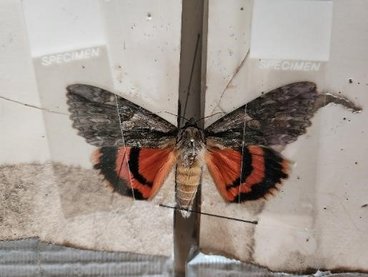
At the SWROC and several other Minnesota locations, we are looking for insect pest species. However, one of the reasons I like running a black light trap is the diversity of insects captured. This past week some of my favorites (Figure 5.) showed up at the SWROC black light trap. Two underwing moth species (Catocala sp.) showed up. If I still had the spare time I did when I was young, I’d spend some of it studying this group of moths. They don’t affect crops, the larvae of most species feed on the leaves of several species of trees. Figure 6. An underwing moth in permanent repose. One of the many uses of duct tape can be seen at the bottom of the picture.
The adults and caterpillars are masters of camouflage, and the moth’s contrasting red, orange, yellow, or black hindwings may have a use in frightening predators or perhaps another purpose known only to the moths.
I might spend an evening this weekend painting a mixture of stale beer, sugar, and ripe fruit on a few tree trunks in the Minnesota River Valley. I might be able to attract a few underwings to visit the bait after dark.
Keep up to date on crop and pest development.
Degree-day development models and blacklight insect captures are available at https://vegedge.umn.edu/degree-day-models-select-insect-pests-midwest-region and https://vegedge.umn.edu/weekly-moth-flights.
Corn growing degree day models along with temperature and precipitation maps can be found at the Midwest Regional Climate Center https://mrcc.purdue.edu/
Happy trails,
Bruce Potter
